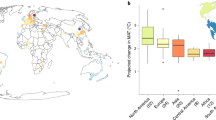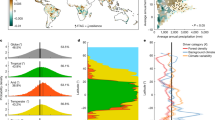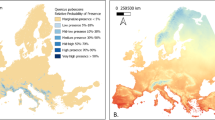Abstract
As cities heat up and expand in area and population, urban forests offer a nature-based solution to enhance liveability and reduce rising temperatures in cities. However, urban forests are vulnerable to climate change and face costly establishment and maintenance challenges. Here we explore four key ecological and socioeconomic barriers to achieving resilient urban forests: species selection, tree supply, tree life cycle (establishment and maintenance, including irrigation) and community engagement. We discuss how integrating traditional urban forestry practices with emerging technology offers a holistic approach to creating resilient, sustainable urban forests that can adapt to climate change while meeting community needs.
This is a preview of subscription content, access via your institution
Access options
Subscribe to this journal
Receive 12 digital issues and online access to articles
$119.00 per year
only $9.92 per issue
Buy this article
- Purchase on SpringerLink
- Instant access to full article PDF
Prices may be subject to local taxes which are calculated during checkout



Similar content being viewed by others
Change history
17 March 2025
A Correction to this paper has been published: https://doi.org/10.1038/s44284-025-00224-y
References
Dyer, G. M. C. et al. Exploring the nexus of urban form, transport, environment and health in large-scale urban studies: a state-of-the-art scoping review. Environ. Res. 257, 119324 (2024).
Emissions Gap Report 2023: Broken Record—Temperatures Hit New Highs, Yet World Fails to Cut Emissions (UNEP, 2023).
April 2024 Was Earth’s Warmest on Record (NOAA, 2024).
Dodman, D., Hayward, B., Pelling, M., Castán Broto, V. & Chow, W. T. in Climate Change 2022: Impacts, Adaptation and Vulnerability. Contribution of Working Group II to the Sixth Assessment Report of the Intergovernmental Panel on Climate Change (eds Pörtner, H. O. et al.) 907–1040 (Cambridge Univ. Press, 2022).
Oke, T. R. City size and the urban heat island. Atmos. Environ. 7, 769–779 (1973).
Steele, W., Handmer, J. & McShane, I. Hot Cities: A Transdisciplinary Agenda (Edward Elgar, 2023).
Klein, R. J. T., Nicholls, R. J. & Thomalla, F. Resilience to natural hazards: how useful is this concept? Glob. Environ. Change B 5, 35–45 (2003).
Miller, R. W., Hauer, R. J. & Werner, L. P. Urban Forestry: Planning and Managing Urban Greenspaces 3rd edn (Waveland Press, 2015).
Keeler, B. L. et al. Social-ecological and technological factors moderate the value of urban nature. Nat. Sustain. 2, 29–38 (2019).
Ballinas, M. & Barradas, V. L. The urban tree as a tool to mitigate the urban heat island in Mexico City: a simple phenomenological model. J. Environ. Qual. 45, 157–166 (2016).
Moss, J. L., Doick, K. J., Smith, S. & Shahrestani, M. Influence of evaporative cooling by urban forests on cooling demand in cities. Urban For. Urban Green. 37, 65–73 (2019).
Esperon-Rodriguez, M. et al. Climate change increases global risk to urban forests. Nat. Clim. Change 12, 950–955 (2022).
Yan, P. & Yang, J. Performances of urban tree species under disturbances in 120 cities in China. Forests 9, 50 (2018).
Tubby, K. & Webber, J. Pests and diseases threatening urban trees under a changing climate. Forestry 83, 451–459 (2010).
Roman, L. A. et al. Human and biophysical legacies shape contemporary urban forests: a literature synthesis. Urban For. Urban Green. 31, 157–168 (2018).
Flörke, M., Schneider, C. & McDonald, R. I. Water competition between cities and agriculture driven by climate change and urban growth. Nat. Sustain. 1, 51–58 (2018).
Vogt, J., Hauer, R. J. & Fischer, B. C. The costs of maintaining and not maintaining the urban forest: a review of the urban forestry and arboriculture literature. Arboricult. Urban For. 41, 293–323 (2015).
Krizek, D. T. & Dubik, S. P. Influence of water stress and restricted root volume on growth and development of urban trees. J. Arboricult. 13, 47–55 (1987).
Esperon-Rodriguez, M. et al. Assessing climate risk to support urban forests in a changing climate. Plants People Planet 4, 201–213 (2022).
Calfapietra, C., Peñuelas, J. & Niinemets, Ü. Urban plant physiology: adaptation-mitigation strategies under permanent stress. Trends Plant Sci. 20, 72–75 (2015).
Brandt, L. et al. A framework for adapting urban forests to climate change. Environ. Sci. Policy 66, 393–402 (2016).
Westoby, M., Falster, D. S., Moles, A. T., Vesk, P. A. & Wright, I. J. Plant ecological strategies: some leading dimensions of variation between species. Annu. Rev. Ecol. Evol. Syst. 33, 125–159 (2002).
Markesteijn, L. & Poorter, L. Seedling root morphology and biomass allocation of 62 tropical tree species in relation to drought- and shade-tolerance. J. Ecol. 97, 311–325 (2009).
Munné-Bosch, S. Limits to tree growth and longevity. Trends Plant Sci. 23, 985–993 (2018).
Messier, C. et al. The functional complex network approach to foster forest resilience to global changes. For. Ecosyst. 6, 21 (2019).
Paquette, A. et al. Praise for diversity: a functional approach to reduce risks in urban forests. Urban For. Urban Green. 62, 127157 (2021).
Pauls, S. U., Nowak, C., Bálint, M. & Pfenninger, M. The impact of global climate change on genetic diversity within populations and species. Mol. Ecol. 22, 925–946 (2013).
Hilbert, D. R. et al. Selecting and assessing underutilized trees for diverse urban forests: a participatory research approach. Front. Ecol. Evol. https://doi.org/10.3389/fevo.2022.759693 (2022).
Huff, E. S. et al. A literature review of resilience in urban forestry. Arboricult. Urban For. 46, 185–196 (2020).
Maliniemi, T. et al. Too much diversity—multiple definitions of geodiversity hinder its potential in biodiversity research. Divers. Distrib. 30, e13843 (2024).
Joyner, J. L. et al. Green infrastructure design influences communities of urban soil bacteria. Front. Microbiol. 10, 982 (2019).
Bonthoux, S. & Chollet, S. Wilding cities for biodiversity and people: a transdisciplinary framework. Biol. Rev. 99, 1458–1480 (2024).
Nix, S., Roman, L. A., Healy, M., Rogan, J. & Pearsall, H. Linking tree cover change to historical management practices in urban parks. Landsc. Ecol. 38, 4227–4245 (2023).
Street Tree Master Plan 2023. City of Sydney https://www.cityofsydney.nsw.gov.au/strategies-action-plans/street-tree-master-plan (2023).
Thompson, I., Mackey, B., McNulty, S. & Mosseler, A. Forest Resilience, Biodiversity, and Climate Change. A Synthesis of the Biodiversity/Resilience/Stability Relationship in Forest Ecosystems (Technical Series no. 43) (Secretariat of the Convention on Biological Diversity, 2009).
McLeod, K. W. Species selection trials and silvicultural techniques for the restoration of bottomland hardwood forests. Ecol. Eng. 15, S35–S46 (2000).
O’Brien, L., Derks, J. & Schuck, A. The Use of Marteloscopes in Science: A Review of Past Research and Suggestions for Further Application (Integrate Network, 2022).
Booth, T. H. The need for a global tree trial database. New For. 54, 1–7 (2023).
Hilbert, D. R. et al. Expanding urban tree species diversity in Florida (USA): challenges and opportunities for practitioners. Soc. Nat. Resour. 36, 891–908 (2023).
Williams, M. I. & Dumroese, R. K. Assisted migration: what it means to nursery managers and tree planters. Tree Plant Notes 57, 21–26 (2014).
Sjöman, H., Hirons, A. & Bassuk, N. Improving confidence in tree species selection for challenging urban sites: a role for leaf turgor loss. Urban Ecosyst. 21, 1171–1188 (2018).
Landis, T. D., Bonner, F. & Karrfalt, R. in The Woody Plant Seed Manual (eds Bonner, F. T. & Karrfalt, R. P.) 125–146 (USDA Forest Service, 2008).
Rae, R. A., Simon, G. & Braden, J. in Urban Forests. Ecosystem Services and Management (ed. Blum, J.) 111–142 (Apple Academic Press, 2017).
Hewett, E. W. High-value horticulture in developing countries: barriers and opportunities. CAB Rev. 7, 1–16 (2012).
Sjöman, H. & Watkins, J. H. R. What do we know about the origin of our urban trees?—A North European perspective. Urban For. Urban Green. 56, 126879 (2020).
Niemiera, A. X. & Holle, B. V. in Management of Invasive Weeds (ed. Inderjit Centre for Environmental Management of Degraded Ecosystems (CEMDE), University of Delhi) 167–187 (Springer, 2009).
Fady, B., Ducci, F. & Vendramin, G. G. in State of Mediterranean Forests 2013 (eds Basacier, C. et al.) 139–146 (FAO, 2013).
Kelleher, C. et al. Approaches to the Conservation of Forest Genetic Resources in Europe in the Context of Climate Change (European Forest Genetic Resources Programme, 2015).
Roman, L. A. et al. Linking urban tree cover change and local history in a post-industrial city. Land 10, 403 (2021).
Chishaleshale, M., Shackleton, C. M., Gambiza, J. & Gumbo, D. The prevalence of planning and management frameworks for trees and green spaces in urban areas of South Africa. Urban For. Urban Green. 14, 817–825 (2015).
Lo, A. Y. & Jim, C. Y. Willingness of residents to pay and motives for conservation of urban green spaces in the compact city of Hong Kong. Urban For. Urban Green. 9, 113–120 (2010).
Gwedla, N. & Shackleton, C. M. The development visions and attitudes towards urban forestry of officials responsible for greening in South African towns. Land Use Policy 42, 17–26 (2015).
Hou, J., Johnson, J. M. & Lawson, L. Greening Cities, Growing Communities (Landscape Architecture Foundation with Univ. Washington Press, 2009).
Eisenman, T. S., Roman, L. A., Östberg, J., Campbell, L. K. & Svendsen, E. Beyond the Golden Shovel. J. Am. Plan. Assoc. https://doi.org/10.1080/01944363.2024.2330943 (2024).
Wattenhofer, D. J. & Johnson, G. R. Understanding why young urban trees die can improve future success. Urban For. Urban Green. 64, 127247 (2021).
Jim, C. Y. Soil volume restrictions and urban soil design for trees in confined planting sites. J. Landsc. Archit. 14, 84–91 (2019).
Di Baldassarre, G. et al. Water shortages worsened by reservoir effects. Nat. Sustain. 1, 617–622 (2018).
Roman, L. A., Battles, J. J. & McBride, J. R. Determinants of establishment survival for residential trees in Sacramento County, CA. Landsc. Urban Plan. 129, 22–31 (2014).
Nitoslawski, S. A., Galle, N. J., Van Den Bosch, C. K. & Steenberg, J. W. N. Smarter ecosystems for smarter cities? A review of trends, technologies, and turning points for smart urban forestry. Sustain. Cities Soc. 51, 101770 (2019).
Russo, A. & Escobedo, F. J. From smart urban forests to edible cities: new approaches in urban planning and design. Urban Plan. 7, 131–134 (2022).
Fini, A. & Brunetti, C. in Routledge Handbook of Urban Forestry (eds Ferrini, F. et al.) 419–433 (Routledge, 2017).
Furumai, H. Rainwater and reclaimed wastewater for sustainable urban water use. Phys. Chem. Earth Parts A/B/C 33, 340–346 (2008).
Brom, P. et al. A decision support tool for green infrastructure planning in the face of rapid urbanization. Land 12, 415 (2023).
Sjöman, H., Hirons, A. D. & Bassuk, N. L. Urban forest resilience through tree selection—variation in drought tolerance in Acer. Urban For. Urban Green. 14, 858–865 (2015).
Mullaney, J., Lucke, T. & Trueman, S. J. A review of benefits and challenges in growing street trees in paved urban environments. Landsc. Urban Plan. 134, 157–166 (2015).
Shashua-Bar, L., Pearlmutter, D. & Erell, E. The cooling efficiency of urban landscape strategies in a hot dry climate. Landsc. Urban Plan. 92, 179–186 (2009).
Simpson, J. R. Improved estimates of tree-shade effects on residential energy use. Energy Build. 34, 1067–1076 (2002).
Heynen, N., Perkins, H. A. & Roy, P. The political ecology of uneven urban green space:the impact of political economy on race and ethnicity in producing environmental inequality in Milwaukee. Urban Affairs Rev. 42, 3–25 (2006).
Bloch, S. Shade (Places, 2019).
Aznarez, C. et al. Luxury and legacy effects on urban biodiversity, vegetation cover and ecosystem services. npj Urban Sustain. 3, 47 (2023).
Barboza, E. P. et al. Green space and mortality in European cities: a health impact assessment study. Lancet Planet. Health 5, e718–e730 (2021).
Li, Y. et al. Green spaces provide substantial but unequal urban cooling globally. Nat. Commun. 15, 7108 (2024).
Kelly, D., Davern, M., Farahani, L., Higgs, C. & Maller, C. Urban greening for health and wellbeing in low-income communities: a baseline study in Melbourne, Australia. Cities 120, 103442 (2022).
Levy, D. K., Comey, J. & Padilla, S. In the face of gentrification: case studies of local efforts to mitigate displacement. J. Afford. Hous. Commun. Dev. Law 16, 238–315 (2007).
Adjei Mensah, C., Andres, L., Baidoo, P., Eshun, J. K. & Antwi, K. B. Community Participation in Urban Planning: The Case of Managing Green Spaces in Kumasi, Ghana Vol. 28 (Springer, 2017).
Broussard, S. R., Washington-Ottombre, C. & Miller, B. K. Attitudes toward policies to protect open space: a comparative study of government planning officials and the general public. Landsc. Urban Plan. 86, 14–24 (2008).
Wüstemann, H., Kalisch, D. & Kolbe, J. Access to urban green space and environmental inequalities in Germany. Landsc. Urban Plan. 164, 124–131 (2017).
Koo, J.-C., Park, M. S. & Youn, Y.-C. Preferences of urban dwellers on urban forest recreational services in South Korea. Urban For. Urban Green. 12, 200–210 (2013).
Shackleton, C. M. & Njwaxu, A. Does the absence of community involvement underpin the demise of urban neighbourhood parks in the Eastern Cape, South Africa? Landsc. Urban Plan. 207, 104006 (2021).
Grant, A., Millward, A. A., Edge, S., Roman, L. A. & Teelucksingh, C. Where is environmental justice? A review of US urban forest management plans. Urban For. Urban Green. 77, 127737 (2022).
Riedman, E. et al. Why don’t people plant trees? Uncovering barriers to participation in urban tree planting initiatives. Urban For. Urban Green. 73, 127597 (2022).
Dakouré, A. & Georges, J.-Y. Urban trees as a lever for citizen engagement in public consultation processes: the case of Paris, France. Front. Sociol. 9, 1345943 (2024).
Puskás, N., Abunnasr, Y. & Naalbandian, S. Assessing deeper levels of participation in nature-based solutions in urban landscapes—a literature review of real-world cases. Landsc. Urban Plan. 210, 104065 (2021).
Anguelovski, I. et al. Expanding the boundaries of justice in urban greening scholarship: toward an emancipatory, antisubordination, intersectional, and relational approach. Ann. Am. Assoc. Geogr. 110, 1743–1769 (2020).
Ordóñez Barona, C. et al. The role of diverse cultural identities in the perceived value of urban forests in Melbourne, Australia, and implications for urban ecosystem research and practice. Ecol. Soc. 28, 1–22 (2023).
Roman, L. A. et al. Beyond ‘trees are good’: disservices, management costs, and tradeoffs in urban forestry. Ambio 50, 615–630 (2021).
Explore Melbourne’s urban forest. City of Melbourne http://melbourneurbanforestvisual.com.au (2020).
Brown, T. B. et al. Using phenocams to monitor our changing Earth: toward a global phenocam network. Front. Ecol. Environ. 14, 84–93 (2016).
Zhang, H., Song, H.-j. & Yu, B.-c. Application of hyper spectral remote sensing for urban forestry monitoring in natural disaster zones. In 2011 International Conference on Computer and Management (CAMAN) https://doi.org/10.1109/CAMAN.2011.5778867 (IEEE, 2011).
Jahani, A., Saffariha, M. & Barzegar, P. Landscape aesthetic quality assessment of forest lands: an application of machine learning approach. Soft Comput. 27, 6671–6686 (2023).
Ramaiah, M., Avtar, R. & Kumar, P. Treated wastewater use for maintenance of urban green spaces for enhancing regulatory ecosystem services and securing groundwater. Hydrology 9, 180 (2022).
Fam, D. et al. Irrigation of Urban Green Spaces: A Review of the Environmental, Social and Economic Benefits (Cooperative Research Centre for Irrigation Futures, 2008).
Wendling, L. A. & Holt, E. E. in Women in Water Quality: Investigations by Prominent Female Engineers (ed. O’Bannon, D. J.) 23–46 (Springer, 2020).
Dyer, G. M. C. et al. Commentary: a road map for future data-driven urban planning and environmental health research. Cities 155, 105340 (2024).
Wilkes-Allemann, J. et al. Envisioning the future—creating sustainable, healthy and resilient BioCities. Urban For. Urban Green. 84, 127935 (2023).
Acknowledgements
M.E.-R. received funding from Research Theme Program from Western Sydney University. C.C. acknowledges the support of the National Biodiversity Future Centre (NBFC) funded by the Italian Ministry of University and Research, P.N.R.R., Missione 4 Componente 2, ‘Dalla ricerca all’impresa’, Investimento 1.4, project number CN00000033. J.C.S. was supported by the Center for Ecological Dynamics in a Novel Biosphere (ECONOVO), funded by Danish National Research Foundation (grant number DNRF173). C.S. was funded by the South African Research Chairs Initiative of the Department of Science and Technology and the National Research Foundation of South Africa (grant number 84379). Any opinions, findings, conclusions or recommendations expressed in this material are those of the authors, and the National Research Foundation (NRF) does not accept any liability in this regard. The opinions and findings expressed in this Review are those of the authors and should not be construed to represent any official United States Department of Agriculture (USDA) or US government determination or policy. Requests for materials should be addressed to M.E.-R.
Author information
Authors and Affiliations
Contributions
M.E.-R., R.V.G. and M.G.T. conceived the article. The manuscript was written by M.E.-R. with contributions from C.C., P.C., C.D., A.A.E., D.E.R., A.J., E.L., S.J.L., G.M., R.M.M., T.M., C.M., J.Ö., L.A.R., A.R., M.S., C.S., H.S., I.S., J.S., J.-C.S., N.v.D., B.W. and J.Y. All authors, M.E.-R., R.G., M.G.T., C.C., P.C., C.D., A.A.E., D.E.R., A.J., E.L., S.J.L., G.M., R.M.M., T.M., C.M., J.Ö., L.A.R., A.R., M.S., C.S., H.S., I.S., J.S., J.-C. S., N.v.D., B.W. and J.Y., contributed to the discussion of the content and reviewed or edited the manuscript before submission. All authors, except for M.E.-R., R.G. and M.G.T., are listed alphabetically.
Corresponding author
Ethics declarations
Competing interests
The authors declare no competing interests.
Peer review
Peer review information
Nature Cities thanks Clive Davies and the other, anonymous, reviewer(s) for their contribution to the peer review of this work.
Additional information
Publisher’s note Springer Nature remains neutral with regard to jurisdictional claims in published maps and institutional affiliations.
Rights and permissions
Springer Nature or its licensor (e.g. a society or other partner) holds exclusive rights to this article under a publishing agreement with the author(s) or other rightsholder(s); author self-archiving of the accepted manuscript version of this article is solely governed by the terms of such publishing agreement and applicable law.
About this article
Cite this article
Esperon-Rodriguez, M., Gallagher, R., Calfapietra, C. et al. Barriers and opportunities for resilient and sustainable urban forests. Nat Cities 2, 290–298 (2025). https://doi.org/10.1038/s44284-025-00212-2
Received:
Accepted:
Published:
Issue date:
DOI: https://doi.org/10.1038/s44284-025-00212-2
This article is cited by
-
Digital Jevons paradox in urban data center energy systems
Nature Cities (2025)
-
Assessing air pollutant removal and carbon sequestration across urban forest stands and individual species in a medium-sized southern Italian city
Environmental Science and Pollution Research (2025)
-
Geospatial evaluation of urban marginal lands for the forestry development in Northern India
Environment, Development and Sustainability (2025)
-
Aboriginal and Torres Strait islander people’s perceptions and preferences of urban forests in Australia
Discover Cities (2025)



